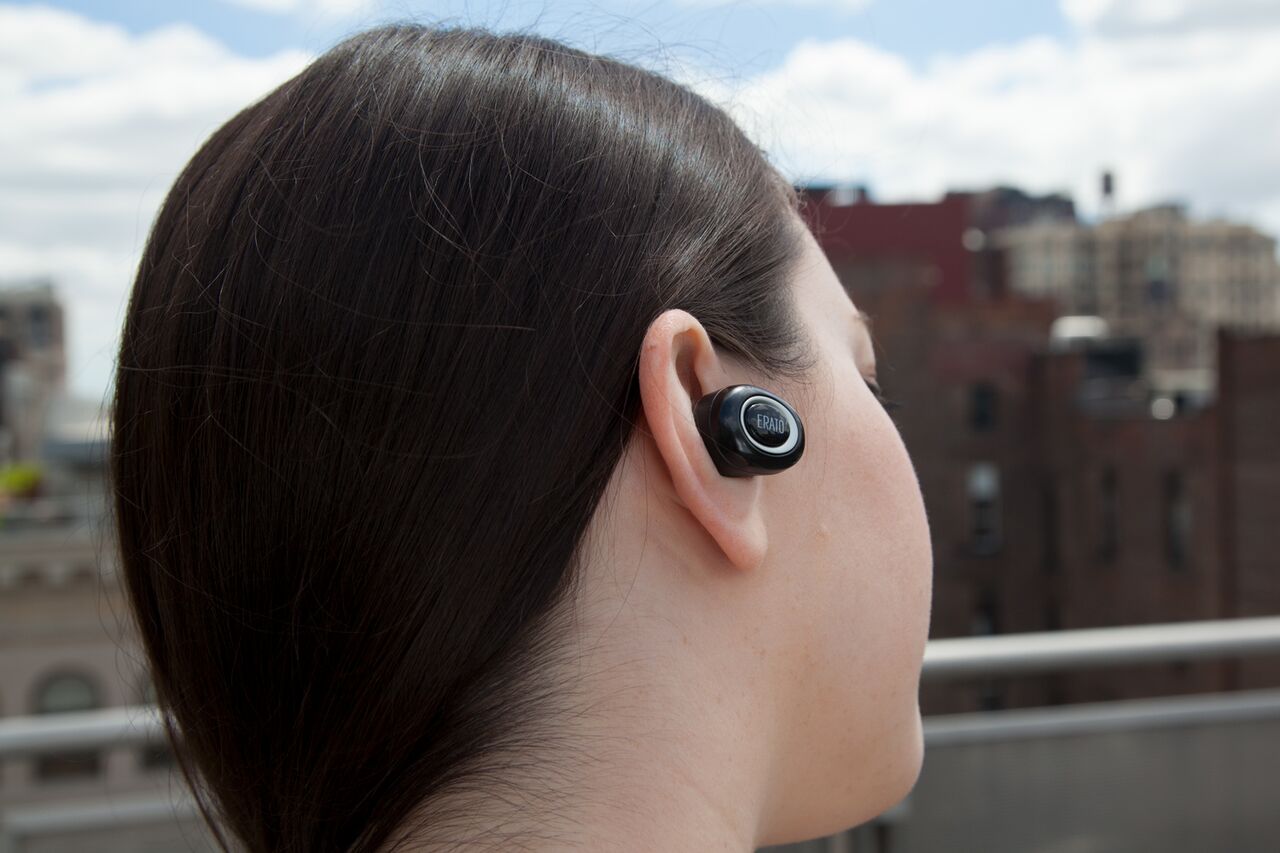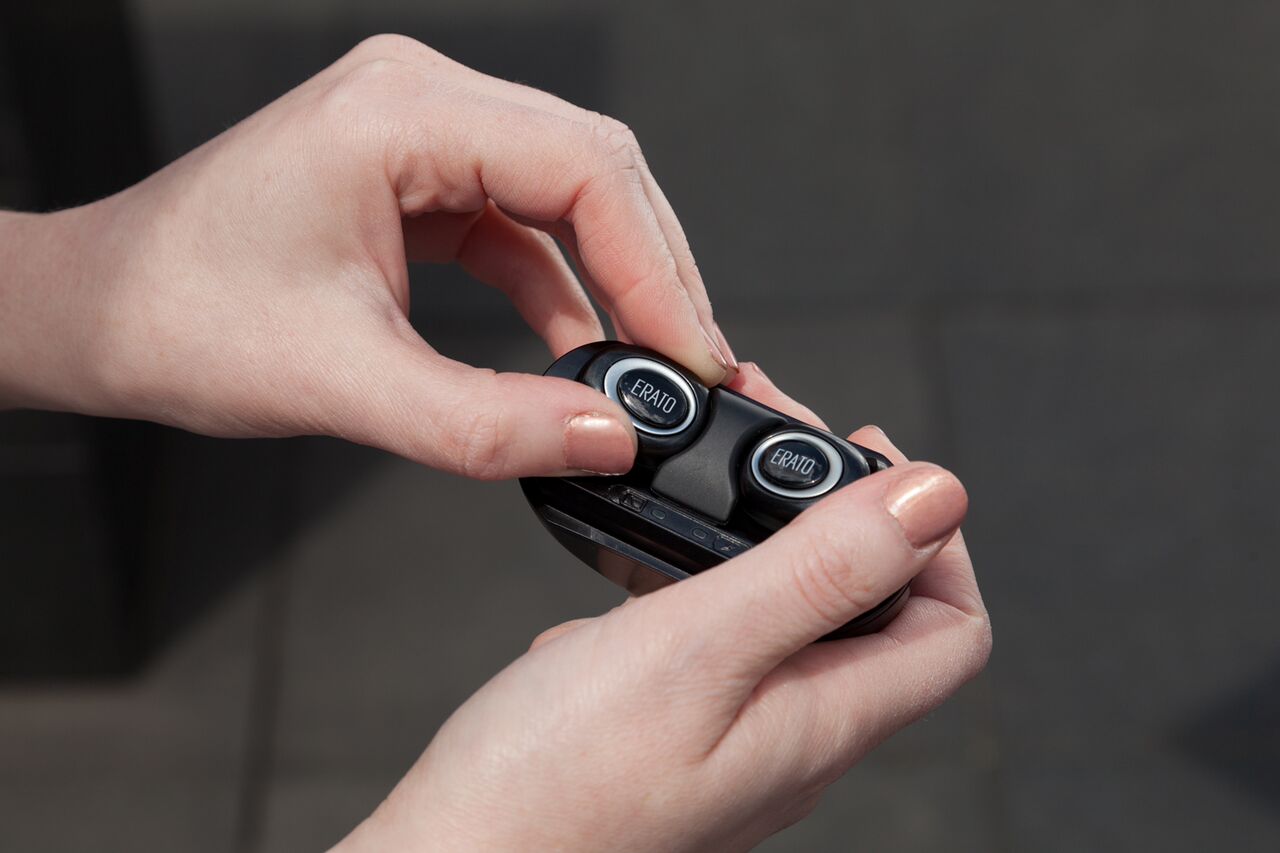Tom's Guide Verdict
The Erato Muse 5 offer a straightforward pairing process with a water-resistant housing and solid audio quality.
Pros
- +
Easy pairing procedure,no complicated app
- +
Block outside noise when sealed properly with FitSeal
- +
Fairly Deep Bass
Cons
- -
Relatively large, cumbersome earbuds
- -
Carrying case is not premium & is too big for pockets
- -
Uncomfortable for long listening periods
- -
Multifunction buttons can get confusing
Why you can trust Tom's Guide
The Erato Muse 5 headphones are an interesting take on the truly wireless earbud, which is quickly becoming a popular form factor. They've got a straightforward design and usage that's almost no-frills and hints at a company still looking for the right combination of form and function. For now, the $179 earbuds offer nearly 4 hours of battery life in an understated, water-resistant design that makes them a good choice for the gym or for casual listening. However, an uncomfortable fit and confusing multifunction buttons keep the Muse 5 from being a top-tier product.
Design
Following its first successful launch, of the Apollo 7 wireless headphones on Kickstarter a little over a year ago, Erato went back to the drawing board and designed the Muse 5 after listening to feedback from customers.
The Muse 5 buds are significantly larger than the Apollo 7s and not as elegant. They are available in four colors: White, Blue, Rose Gold and our sample's color, Black.
The Muse 5 are a pair of oval-shaped plastic earbuds with a chrome accent surrounding the large multifunction button adorned with the Erato logo. Stylistically, the truly wireless buds are unassuming and likely to draw less attention than the popular Apple Earpods, with their distinctive form factor.

The backside of each earbud features a two-part design: the traditional silicon tip that fits into your ear canal and a larger silicon component that Erato calls the FitSeal sleeve. This is designed to help block out sound. Both parts are replaceable, and an assortment of sizes is included in the box to ensure you'll get the best fit and sound.
MORE: I Spent More Than $200 on Headphones: You Should Too
These headphones are IPX5-rated, which means they're water-resistant, making them a good choice for the gym. However, without an ear hook, they're prone to falling out during vigorous workouts.
The Muse 5 buds come in a rounded storage container that also functions as a charger. The top half of the container comes off completely to reveal the two buds. While certainly functional, this is not the most elegantly designed container, especially compared to the Skybuds' Skydock. I would have preferred that the case flip open rather than come apart, because the detachable design gave me one more thing to fumble with as I was trying to get to the earbuds.
Comfort, Fit and Connectivity
I wouldn't call the Muse 5s uncomfortable, but they are quite bulky in comparison to other, more traditional earbuds. Luckily, because of their plastic construction, they are fairly lightweight. For me, the ability to change the FlexSeal sleeve made a big difference. I had a much more difficult time getting a secure fit with the Skybuds.

I have spent some time with a few other wireless earbuds, including the Earin M1 and the Skybuds. Connection issues have been users' biggest headache with wireless earbuds, and I've experienced that issue firsthand with the other pairs I have tried. However, the Muse 5s had a stable and reliable connection and only briefly hiccupped twice while I walked around my apartment, going no farther than 25 feet away from my phone.
Usage
With just a single button on each bud, many functions are accessible only by utilizing a specific button sequence, such as a single press, multipress or press/hold. Depending on whether you're listening to music, taking a phone call or just wearing the earbuds, each button sequence has a different use.

The one-button setup made for some frustrating situations. In some cases, I either pressed too slow or held too long and did something completely different from what I had intended, including turning the buds off or re-entering pairing mode. I really wish there were a separate rocker button to control volume, as it would simplify the multibutton sequences. For a complete list of all the sequences, I'd recommend reading the user manual.
The company's report of a 10-meter (30 feet) connection range is fairly accurate. The buds even worked through walls while I walked around my apartment.
Audio Quality
Anyone looking for a completely wireless headphone is likely to be more concerned about the wireless functionality than the audio quality, but good sound is always a perk.

The Muse 5 headphones offer a decent amount of bass, without overdoing it. However, the bass was a little muddy and certainly not as tight as on similarly priced wired headphones. Additionally, the midrange and treble were a bit lackluster, missing some clarity and sparkle.
Erato also includes a digital signal processing (DSP) mode called EratoSurround, which the company claims, "can reduce sound image distortion to create a more accurate sound." There are three modes: 3D Normal, 3D Wide and off. The 3D Normal mode is more accurate than the Wide version, which mimics a concert hall; however, the sound was most accurate when the mode was turned off completely.
When I listened to Disturbed's Grammy Award-winning version of "The Sound of Silence," David Draiman's raspy vocals were clear and forward. However, when compared to the Skybuds' production, there were subtleties and nuances that were much less pronounced and forward.
MORE: Buying Headphones: Pros and Cons of Every Type
During Manzanita's "Arranca" — a Cuban-inspired toe-tapper that was used in the 2006 remake of Miami Vice — the acoustic guitars, pianos, drums, percussion, horns and smoky male vocals were fairly enjoyable, but again, the horns were missing a bit of their brightness.
I made several phone calls over the course of my testing. Everyone I spoke to said the audio was quite clear and understandable. But similar to the Skybuds, phone call audio will register only in the left earbud, something I hope can be fixed in the next version.
Battery Life
Erato claims that the Muse 5s are good for up to 4 hours of usage, which seemed fairly accurate, as the buds lasted approximately 3 hours 30 minutes at a higher volume level. The bundled storage container can hold two full charges, providing three full uses if the buds are charged simultaneously. The Skydock that houses the Skybuds can charge them a whopping six times before it needs to be plugged in.

The Muse 5's storage container can be charged using the included micro USB cable. However, Erato didn't think consumers needed an actual plug, so you're on your own with that. Both the storage container and buds charge fairly quickly, in 2 hours, despite the absence of the quick-charging technology found in the Apple Airpods ($159).
Bottom Line
The Erato Muse 5 headphones are fairly easy to use. Pairing was a breeze, and sound quality was decent, with adequate bass response when it was needed. With 4 hours of battery life, you will certainly need to charge these headphones during a heavy-usage day, but they should get you to and from work without any issues. And since they charge when docked in the case, that should be no problem.
However, they are not without some design flaws, which can hopefully be corrected in a future generation. Due to their size, the buds can become uncomfortable after a few hours, though changing the FitSeals did help remedy this to some extent. They'd be just about perfect if they were only 25 percent smaller. The case also needs a redesign, especially when compared to the Skybuds' ($199) elegant case, which offers more charging opportunities for the buds. I'd also recommend the Skybuds if you're a stickler for audio quality.
Overall, the Erato Muse 5s are a good choice for music lovers looking for a relatively no-fuss approach to truly wireless earbuds.
Credit: Shaun Lucas/Tom's Guide
Charles A. Cohen is a US-based freelance writer specializing in audio news, reviews and features. He has tested a wide variety of earbuds, on-ear and over-ear headphones for Tom's Guide at a range of different budgets. When not testing out headphones, he can also be found experimenting with Bluetooth speakers and other home audio products.

